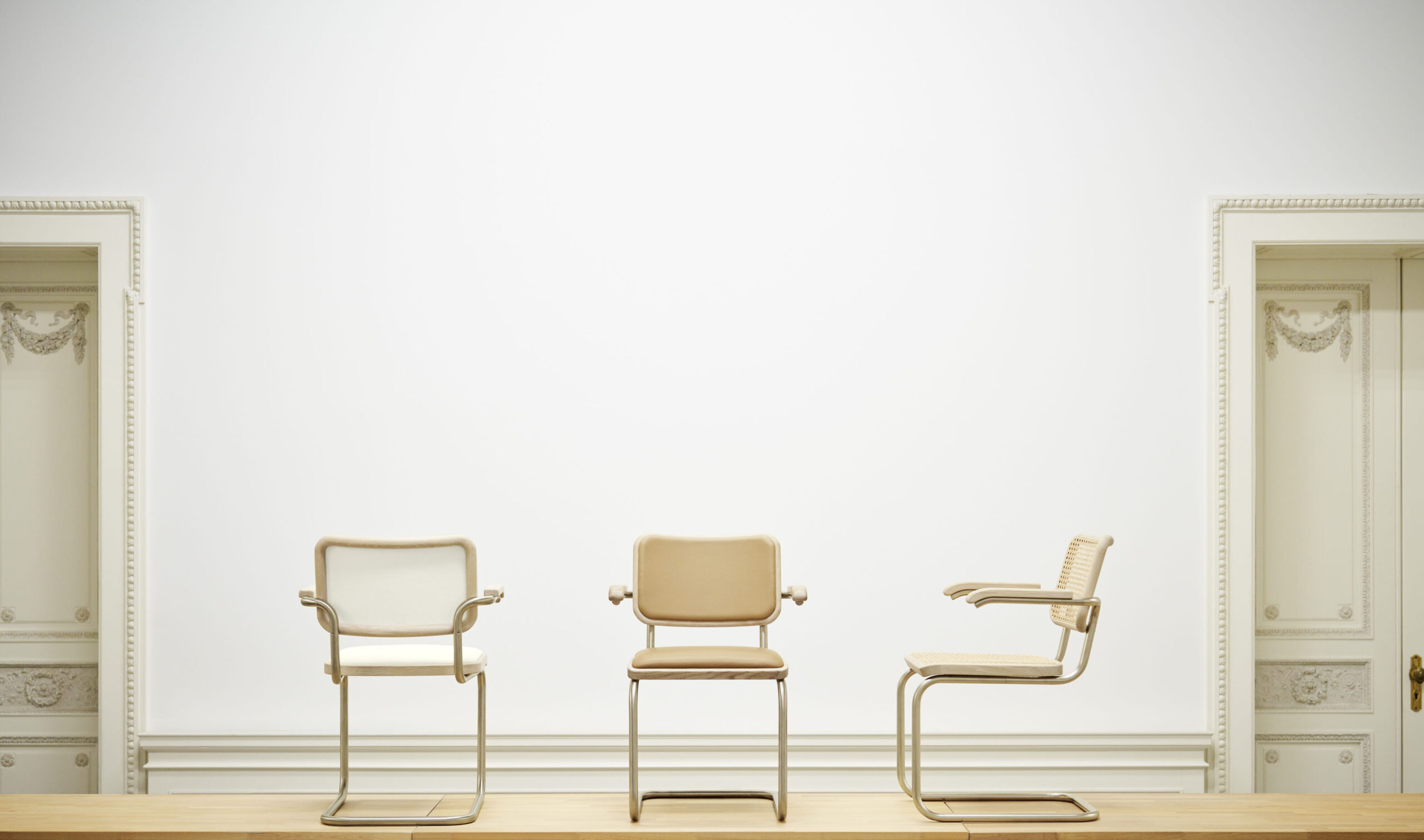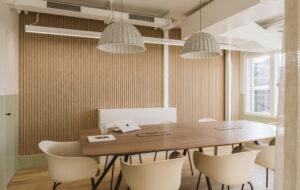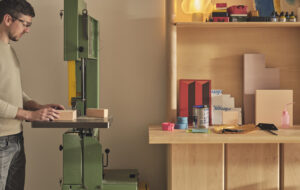
 The best way to describe Industrial Facility is its direct contrast to celebrity design culture. Philippe Starck is the obvious counterpoint. Silent versus loud, invisible versus omnipresent, anonymity versus ego… and yet Starck is the studio’s biggest fan. This month Industrial Facility has its first ever UK exhibition opening at the Design Museum, and Monsieur Starck jumped at the chance to write the intro text for the show. In a design world of flamboyance and art obsession, it is refreshing to see the big names in awe of real craft. Industrial Facility designs mass-produced appliances on a simple quest to improve. Luckily for the office world, it is launching a desk for Herman Miller this month too.
The best way to describe Industrial Facility is its direct contrast to celebrity design culture. Philippe Starck is the obvious counterpoint. Silent versus loud, invisible versus omnipresent, anonymity versus ego… and yet Starck is the studio’s biggest fan. This month Industrial Facility has its first ever UK exhibition opening at the Design Museum, and Monsieur Starck jumped at the chance to write the intro text for the show. In a design world of flamboyance and art obsession, it is refreshing to see the big names in awe of real craft. Industrial Facility designs mass-produced appliances on a simple quest to improve. Luckily for the office world, it is launching a desk for Herman Miller this month too.In 2000, Sam Hecht, ex head of design at Ideo, and Kim Colin, architect and publisher, founded the Clerkenwell-based design studio. Their venture had a high level of maturity right from the start, and their no logo approach earned them most recognition in Japan. “Style restricts,” says Hecht. “The arty design phenomenon is an acceptable form of the market but it’s not ours. We are inherently curious and style negates curiosity.” Nevertheless there are clear common threads that weave through Industrial Facility’s work. Its designs are not form based – there is always a subversive narrative – and the ingenuity is discovered through the use of the objects. Its interest and starting point was a thorough and genuine interest in industry – hence the name. “Industrial meaning mechanism,” says Colin. “Facility standing for manufacturing as well as for ease.” “Industry is not a bad word for us,” Hecht adds. “It’s not a vision of smoking chimneys.”
This pure interest in industry is in part the reason for the support and success Industrial Facility has experienced in Japan. Hecht has a professional history with Naoto Fukasawa, which set the tracks for the studio’s direction from the start. Its first projects were for Muji and commissions for Idea followed, products of which will be shown for the first time in the UK at the Design Museum event. “Fukasawa put us in touch with Muji, a company that typifies a set of values close to us, and gave us an opportunity to present a new set of criteria,” Hecht recalls. Through these collaborations Hecht and Colin hooked up with Ippei Matsumoto, a young Japanese product designer who the pair now views as an integral part of Industrial Facility.
“Ippei and Sam work on the product design detail,” Colin explains, “while I work more on a macro level, reading, editing, translating and contexualising architecturally.” With Colin being American, Matsumoto Japanese and Hecht British, an international design language resonates through their portfolio. But essentially its attitude to the market is what makes Industrial Facility differ from most British-based studios. “Our work is not exactly flavour of the month,” Hecht says, “so it was brave of Deyan Sudjic to invite us to exhibit. At the moment, popular design has different parameters to our work – it’s about personality, character, expensive materials and entertainment value. We tend to go for uncomplicated and inexpensive. We want our products to connect with the landscape of use, not create a pseudo character for an object.”
Overall, Industrial Facility follows a principle (also applied by Fukasawa, see onoffice issue 08) of not looking at what others do. “In the UK, the bottom line is a commercial endeavour,” Hecht continues. “The people pulling the strings are risk averse, especially in the office product world. The market seems driven by competitions, so everyone is always looking at what their next-door neighbour has on the shelf. We ignore that.” Colin says the model of marketing hasn’t advanced – it’s still based on eliminating risk, what the competition is doing and sales. “But manufacturing has become a commodity now,” she says. “We believe a new model is due to free designers from ‘looking at the shop shelf’ and design something open.”
This is where the new Herman Miller desk, Enchord, comes in as a great example. Industrial Facility was invited by the American furniture manufacturer to give a lecture in Michigan. After the company was struggling to find the right designers for an “eclectic” home-office project, they finally turned to Industrial Facility. “The furniture industry is like a broken record,” says Hecht. “Most products, especially in the office sector, are over specified, with companies ‘over promising’ what furniture is or can do.” The studio’s vision, after raiding the Herman Miller archives with its Eames and Nelson classics (European rights owned by Vitra), was to design something open. “Your design process may be full circle but in reality products are used in any way, and go anywhere,” says Hecht. “Eames had that foresight to design with flexibility in mind regarding the landscape of use – his work was open and that’s the key to his designs’ ongoing success.”
Industrial Facility has a dogmatic approach to commissions. Firstly, it needs to be able to question the clients’ conclusions. With the Herman Miller brief, for instance, the studio said, “The home office is a myth.” People working from home will make do with whatever they find – a kitchen table will become a desk, a random box will be storage, people don’t specify for the home. “We listened to what Herman Miller wanted,” says Hecht, “then went away as we always do to engage in an intellectual debate to assess the validity of the client’s desires.”
Industrial Facility’s second rule is to only present one concept. In the case of this office desk, its concept was a split-level table, stripped of any extras – and although this function may not be new, the simplicity of the look, as well as the assembling process, makes Enchord an intuitive desk. The upper level fits the ideal New York urban measurement, according to Herman Miller research. The lower table surface creates a storage level for printers, scanners and the like while functioning as storage for keyboards and cable management, and it comes with a drawer as a possible accessory. The table is made of dye-cast aluminium and comes in white or oak and green. There is a filing cabinet to go with it that has the same depth as the desk. “We wanted the table to be childlike in its obviousness. You don’t need a manual,” says Hecht. Indeed with only four components the assembling process couldn’t be easier.
In an industry where products such as task chairs (see onoffice issue 18) are often so far removed from the customer, this considered and straightforward design sets the tone for workplace solutions. The fact that Herman Miller will be rolling the launch of this desk globally is a sign of its “openness”. The fact that it’s the cheapest product the manufacturer has ever produced (at a retail prices of approximately $500, to be confirmed) is a further indicator for balancing out an over-specified market. “Office companies always insist on adding features. We stripped everything back because ergonomics can be limiting, not the study but the style,” says Colin. “It’s like a knife. The more specified features it has, the harder it can be manipulated to be used in another way, but when you’re cutting bread and then want to curve out a melon you want that knife to be a tool that facilitates your imminent need.”
Industrial Facility’s work doesn’t scream features – its products don’t become gadgets, they simply optimise the given. At the Milan furniture fair this year, for instance, Industrial Facility launched a stunning cantilever piano for Yamaha in a resin material. The relationship between the digital aspects and resin is a radical monument to electronic sound. “We stripped away the metaphor of the piano. The white resin feels cold, and the 89th key is a removable remote control,” Hecht explains. For British manufacturer Established & Sons, Industrial Facility launched a clean clock that simultaneously shows the time of two places in the world. The design is so simple that one wonders how no one has ever designed this clock before. And that’s the trick behind the studio’s ideas. It stands back and looks at the fundamental use, asking, “What could be done better?”
The studio’s upcoming product launch for Japanese company Idea, for instance, demonstrates how it will take a banal product like its famous calculator, or the travel clock, and install a better product. “We start from zero,” Hecht says. “With the travel clock we thought about when we travelled and used one, how frustrating it was that you can’t see both the time and the alarm time on one screen so we set out to design one better.” The travel alarm will be half the size of a passport. Every aspect of use is thought through. It has also just designed a plug-in emergency torch for Idea with a motion sensor and night mode with three LEDs that shine in case of a power cut.
The Design Museum exhibition, from 9 May – 7 September, is showing many products unseen in the UK, such as a coffeemaker, a toilet brush and the Circumference Watch for Muji, the Little Disk Hard Drive Program for LaCie and the only UK product, the Knife Program for Sheffield company Taylors Eye Witness. In addition there’s a side collection, which consists of items Hecht has collected over the years on his international travels for “under a fiver”. Each item exists out of a local rather than global human need and has clearly influenced the practice’s thought process. Herman Miller is also due to make an announcement about further collaborations with Industrial Facility this summer, which indicates that the studio is en route to become a permanent fixture in the office furniture world. And maybe that will help to free the industry from over-specified saturation.
























